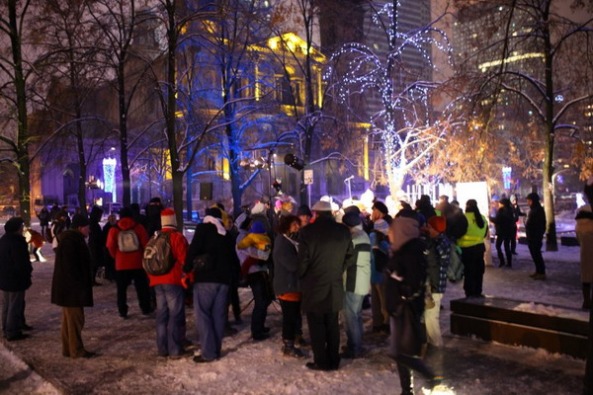
Sep. 17, 1939 – Warsaw Castle clock tower at fire
73 years ago at the beginning of WW2 and during the second week of the defending battle of Warsaw – on Sep. 17, 1939 – the Royal Castle of Warsaw was for the first time hit by a German missile…. the clock on top of the Sigismundus Tower stopped at 11.15 a.m. The Royal Castle was not a military object, it was however the important symbol of the Polish State – once the official residence of the Polish Kings and the longest permanent seat of the Polish Parliament Houses, just before the WW2 – the official Residence of the President of the Republic of Poland.
As such it became a military target. On September 17, 1939, the Castle was shelled by German artillery. The roof and the turrets were destroyed by fire (they were partly restored by the Castle’s staff, but later deliberately removed by the Germans). The ceiling of the Ballroom collapsed, resulting in the destruction of Marcello Bacciarelli’s beautiful ceiling fresco The Creation of the World. The other rooms were slightly damaged. But immediately after the seizure of Warsaw by the Germans, their occupation troops set to demolish the castle. The more valuable objects, even including the central heating and ventilation installations, were dismantled and taken away to Germany.
On 4 October 1939 in Berlin, Adolf Hitler issued the order to blow up the Royal Castle. On 10 October 1939, special German units, under the supervision of history and art experts (Dr. Dagobert Frey, an art historian at the University of Breslau (now: Wrocław); Gustaw Barth, the director of museums in Breslau, and Dr. Joseph Mühlmann, an art historian from Vienna) started to demount floor, marbles, sculptures and stone elements such as fireplaces or moulds. The priceless artifacts were taken to Germany or stored in Kraków’s warehouses. Many of them were also seized by various Nazi dignitaries who resided in Warsaw. The Castle was totally emptied.
Disobeying German orders, and always in danger of being shot, Polish museum staff and experts in art restoration managed to save many of the works of art from the castle, as well as fragments of the stucco-work, the parquet floors, the wood panelling, etc. These were later used in after-war reconstruction. The great service done to Poland by Professor Stanisław Lorentz, in leading this campaign to save the castle’s treasures, is well known. Wermacht sappers then bored tens of thousands of holes for dynamite charges in the stripped walls.
In September 1944, during the Warsaw Uprising, the Germans blew up the Castle’s demolished walls. Leveling the Royal Castle was only a part of a larger plan – the Pabst Plan – the goal of which was to build a monumental Community Hall (ger. Volkshalle) or an equally sizable Congress Hall of NSDAP (National Socialis German Workers Party – ger. Parteivolkshalle) in the Royal Castle’s place and to replace the Zygmunt’s Column with the Germania Monument.
This slideshow requires JavaScript.
A pile of rubble, surmounted by only two fragments of walls that somehow managed to survive, was all that was left of the six hundred year old edifice. On one of these fragments, almost like a symbol, part of the stucco decoration remained. This was a cartouche with the royal version of the motto of the Order of the White Eagle — “PRO FIDE, LEGE ET GREGE” (for Faith, Law, and the Nation – literally translated, the last word means a herd).
After the war the Castle has been totally reconstructed…. but this is another story……














































































